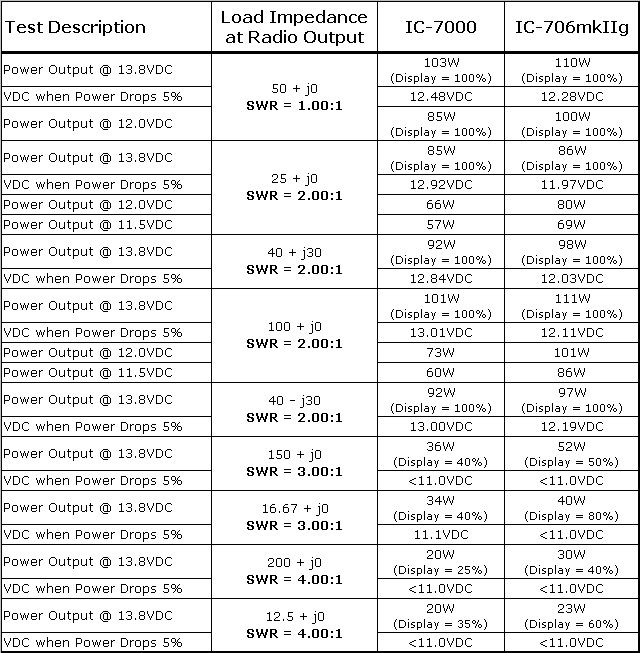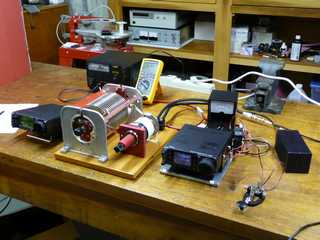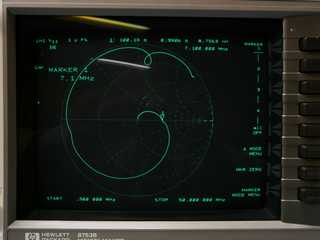I have both an Icom 706mkIIg and and Icom 7000 and have made several thousand mobile contacts on each radio. While there are many things to like about the IC-7000 compared to the IC-706mkIIg such as the noise reduction there are also a few things that I like better in the 706. The IC-7000 always seems to back off the output power more quickly with rising SWR and with lower DC feed voltages than the 706 does. The other thing I like better about the 706 is the audio output level for driving a speaker is higher than in the IC-7000.
I decided to do a test to see if I could measure any differences in the power outputs with the radios out of my vehicle. I needed to generate some predictable impedances that would represent various SWRs to each radio and needed to measure the power delivered by each radio to the load. Rather than trying to measure dissipative power into a reactive load I used a very large L network to transform a 50 ohm dummy load and RF power meter to the desired impedances as shown in the two example circuits at the right. L networks are generally the lowest loss matching networks and this network was constructed fram a 3/8" silver ribbon variable inductor good for several kW and a 5kV vacuum variable capacitor. Simulations showed the expected loss for this network to be less than 0.1dB for all impedances I transformed which is negligible.
I decided to do a test to see if I could measure any differences in the power outputs with the radios out of my vehicle. I needed to generate some predictable impedances that would represent various SWRs to each radio and needed to measure the power delivered by each radio to the load. Rather than trying to measure dissipative power into a reactive load I used a very large L network to transform a 50 ohm dummy load and RF power meter to the desired impedances as shown in the two example circuits at the right. L networks are generally the lowest loss matching networks and this network was constructed fram a 3/8" silver ribbon variable inductor good for several kW and a 5kV vacuum variable capacitor. Simulations showed the expected loss for this network to be less than 0.1dB for all impedances I transformed which is negligible.
All tests were done with both radios set to the maximum power level, at a frequency of 7.1MHz., and with the mode set to CW. My experience is that both radios act the same on all bands concerning the power output and I really didn't want to do too many tests so the tests were all done at 7.1MHz. A straight key plugged into each radio was used to key the RF. A variable voltage DC supply capable of 35A continuous was used and the DC voltage was fed to the radios through 4 ft. of #12 wire from the power supply using Icom cables that were shortened but had the original fuses in them. The DC voltage was measured at the power supply and I realize that the short cable would have a small voltage drop by the time the radio sees the voltage. However both radios had the same cabling lengths and wire sizes.
No measurements were made to detect any possible spurious signals or distortion on the output signals. Power in watts was the only parameter measured. The old Drake RF power meter matches my 2 Bird meters pretty closely and may not be super accurate but it is close and for comaprisons between the 2 radios relative numbers are all that are important.
In order to generate a desired load for the radios I connected my network analyzer to the coax that would connect to each radio and tuned the L network until I had the desired impedance. This can be seen in the picture at the lower right showing the L network tuned to an impedance of 100 +j0 ohms approximately. Then the coax was connected to each radio for the test.
The results shown in the table at the bottom of this page clearly show that the IC-7000 I tested backs off the output power quicker than the IC-706mkIIg and that it needs a slightly higher DC voltage to produce the power. This may not be true for all IC-7000s but other folks have told me they feel the 7000 needs a higher voltage to produce full power and many of these people had used the 706 previously. I used a 5% drop in power as the point where the DC voltage was measured in the table below. The power indication on the IC-7000 display is more correct especially at high SWR's with low impedances such as 16.67 + j0 and 12.5 + j0 where the 706 said the radio was producing twice as much power as it really was.
No measurements were made to detect any possible spurious signals or distortion on the output signals. Power in watts was the only parameter measured. The old Drake RF power meter matches my 2 Bird meters pretty closely and may not be super accurate but it is close and for comaprisons between the 2 radios relative numbers are all that are important.
In order to generate a desired load for the radios I connected my network analyzer to the coax that would connect to each radio and tuned the L network until I had the desired impedance. This can be seen in the picture at the lower right showing the L network tuned to an impedance of 100 +j0 ohms approximately. Then the coax was connected to each radio for the test.
The results shown in the table at the bottom of this page clearly show that the IC-7000 I tested backs off the output power quicker than the IC-706mkIIg and that it needs a slightly higher DC voltage to produce the power. This may not be true for all IC-7000s but other folks have told me they feel the 7000 needs a higher voltage to produce full power and many of these people had used the 706 previously. I used a 5% drop in power as the point where the DC voltage was measured in the table below. The power indication on the IC-7000 display is more correct especially at high SWR's with low impedances such as 16.67 + j0 and 12.5 + j0 where the 706 said the radio was producing twice as much power as it really was.
Click on any pic for higher resolution image


The IC-7000 wants really heavy or short cabling to a good condition battery with an antenna that has low SWR if you want it to produce full power when the vehicle has the motor shut off. In no case did either radio produce any additional power when the DC voltage was increased above 13.8V. A battery boost circuit might be worth looking into if you want the maximum power out of the IC-7000 especially if you operate with the engine off.
Page content last updated Mar. 26, 2008
Copyright © 2008 Larry Benko, W0QE



